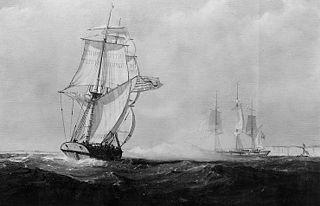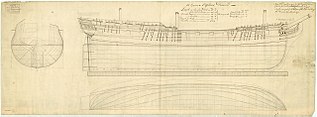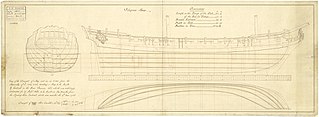| History | |
|---|---|
| | |
| Name | Glasgow |
| Ordered | 13 April 1756 |
| Builder | John Reed, Hull |
| Laid down | 5 June 1756 |
| Launched | 31 August 1757 |
| Commissioned | March 1757 |
| General characteristics | |
| Class and type | 20-gun Sixth rate |
| Tons burthen | 451 bm |
| Length |
|
| Beam | 30 ft 6 in (9.3 m) |
| Depth of hold | 9 ft 7+1⁄2 in (2.9 m) |
| Complement | 160 officers and men |
| Armament | 20 × 9-pounder guns |
HMS Glasgow was a 20-gun sixth-rate post ship of the Royal Navy. She was launched in 1757 and took part in the American Revolutionary War. While under command of Capt. William Maltby she ran onto rocks at Cohasset, Massachusetts on 10 December 1774. Refloated and arrived in Boston on the 15th for repairs. Capt. Maltby was relieved of command at a Court Martial and replaced by Tyringham Howe some time between 8–15 January 1775. [1] She is most famous for her encounter with the maiden voyage of the Continental Navy off Block Island on 6 April 1776. In that action, Glasgow engaged a squadron of 6 ships of the Continental Navy, managing to escape intact. [2] Under the command of Tho. Pasley, she captured sloop Juliana on 1 April 1777. She captured sloop Unity on 2 April 1777. She captured the sloop Betsy & Ann on 4 April. She captured sloop Volante on 5 April. She captured the brig Aurora on 10 April. She captured sloop Sally on 16 April. She captured American privateer sloop Henry on 19 April. She captured schooner Providence on 2 May. She captured schooner Nancy, probably in early May. She captured schooner Betsy 27 June. She captured brig Dolphin on unknown date. She captured sloop Rover on 24 July. She captured sloop Antonio on 21 July. She captured sloop Tryall on 25 July. She captured an unknown schooner on an unknown date. She captured schooner Gen. Thompson on an unknown date. She captured sloop Industry at an unknown date. She captured schooner Betsy & Ann on 4 November. She captured brig Sally on 8 December. She captured sloop Defiance and schooner Success on 9 December. She captured brig Minerva on 19 December. She captured schooner Happy Return on 22 December 1777. [3] On 28 February 1778, she captured sloop Abigale 5 leagues east northeast of the Tiburon Peninsula. [4] On 9 March 1778, she captured schooner Nancy 6 leagues off Mayaguana, Bahamas. [5] She captured sloop Lucy on 12 March off the south east end of Mayaguana. [6] She captured a prize in April 1778, but it sprang a leak and sank. [7]
She later chased two large Continental frigates in the Caribbean before she was accidentally burned in Montego Bay, Jamaica in 1779. [8]














